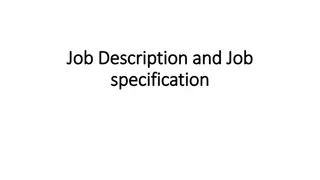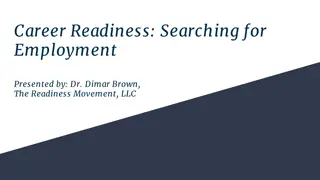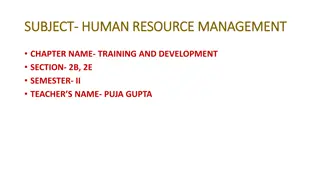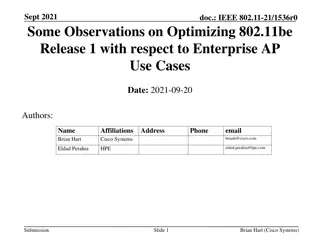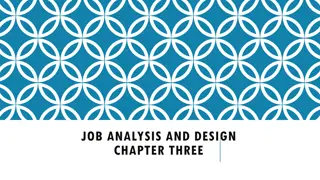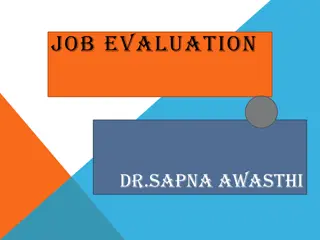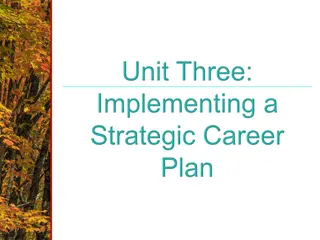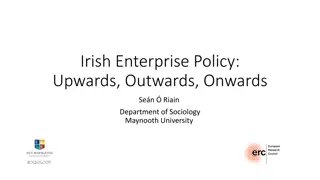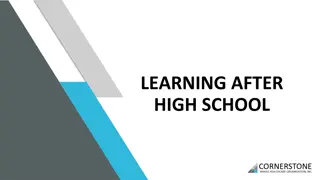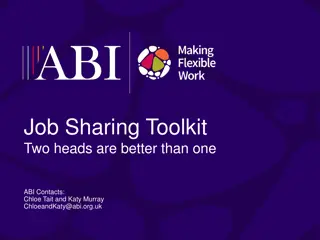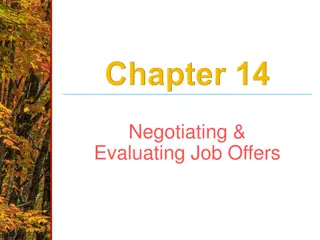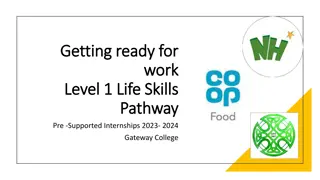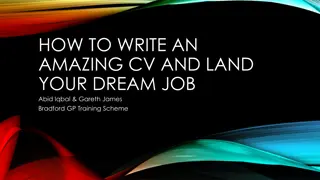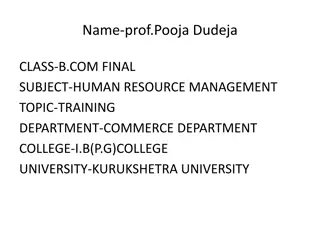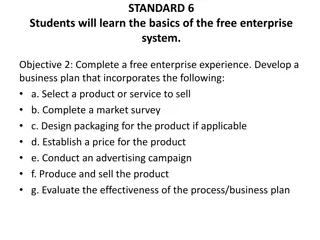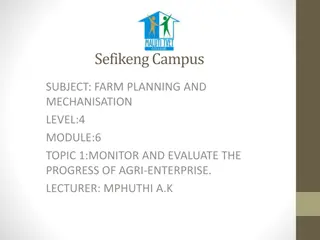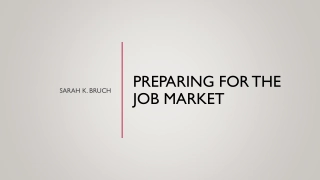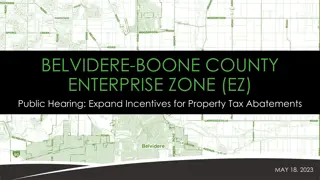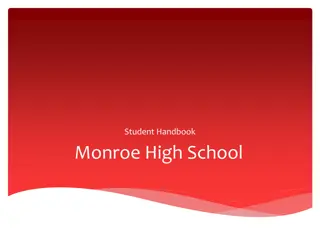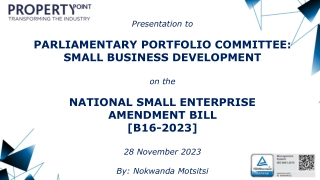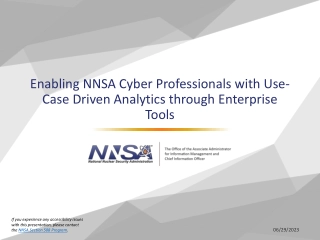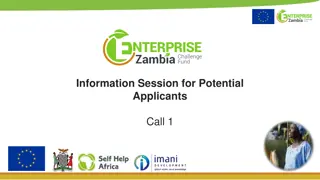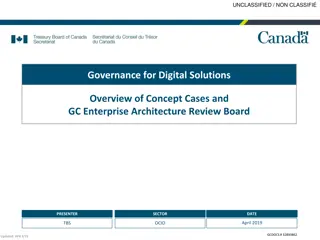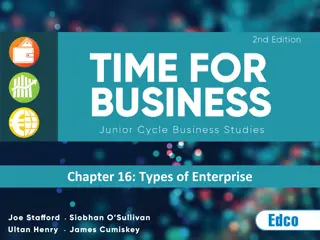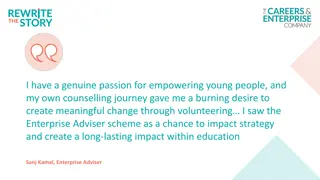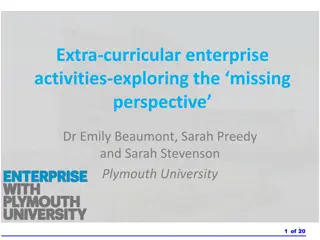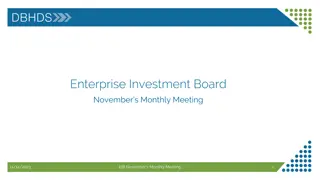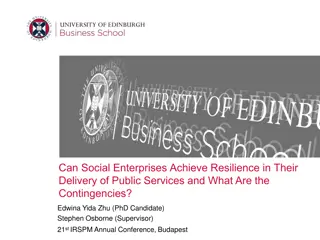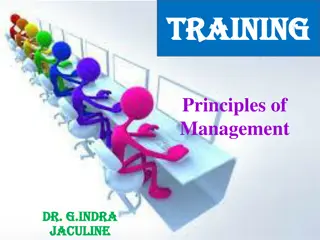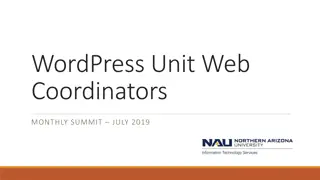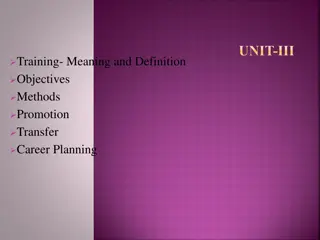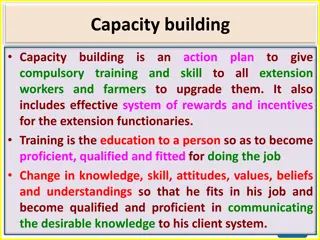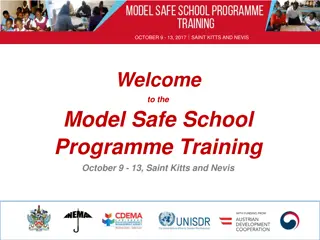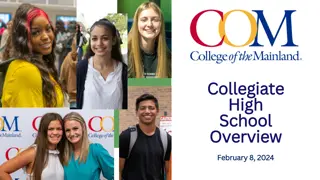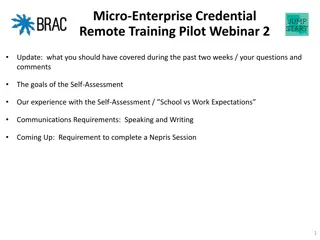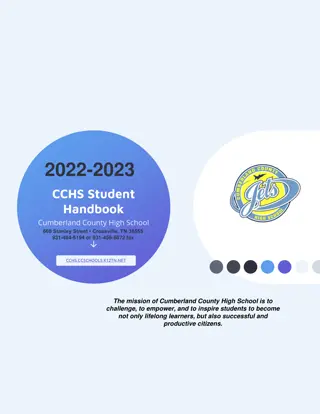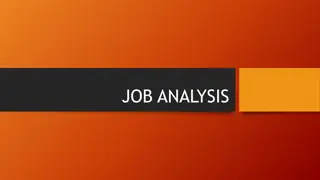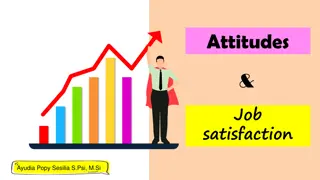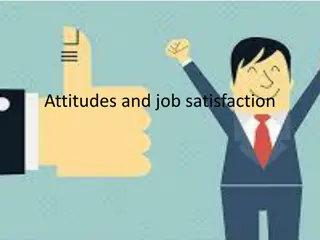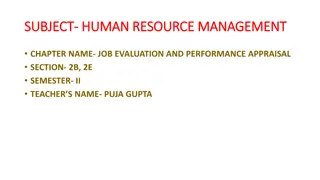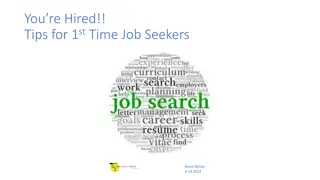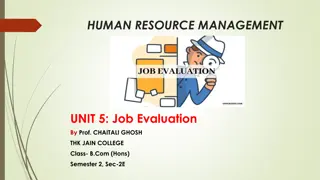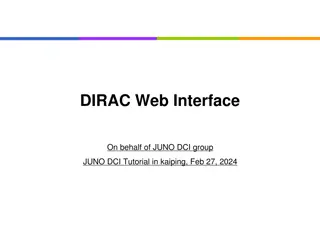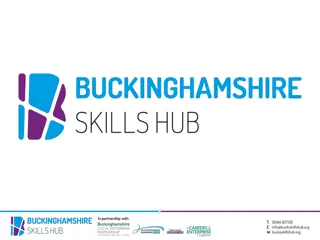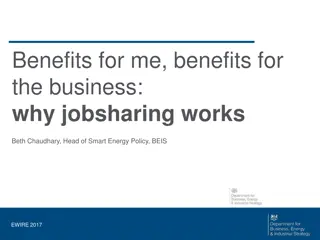Comprehensive Overview of Students' Enterprise School Job Training
Students' Enterprise School Job Training program aims to stimulate self-motivated entrepreneurship, expose young individuals to the business world, and help them gain awareness of entrepreneurial choices. The program is structured in phases, including finding an idea, organizing, and budget definition. Various game activities are integrated to make learning engaging, such as finding business ideas, analyzing their feasibility, and fostering creativity. Students also learn about entrepreneurship qualities, innovation, and the Blue Ocean strategy to open up new market spaces.
Download Presentation

Please find below an Image/Link to download the presentation.
The content on the website is provided AS IS for your information and personal use only. It may not be sold, licensed, or shared on other websites without obtaining consent from the author. Download presentation by click this link. If you encounter any issues during the download, it is possible that the publisher has removed the file from their server.
E N D
Presentation Transcript
STUDENTS ENTERPRISE SCHOOL JOB TRAINING IMPRESA IN AZIONE C2 PILOT LTTA - SEVILLE 09-16/11/2019 Junior Achievement Marche
STUDENTS ENTERPRISE AIMS 1. To stimulate self-motivated enterprise by emphasizing positive initiative, a spirit of innovation and creativity. 2. To prepare young individuals for and expose them to the workaday world by presenting examples of business models and practices, professional roles and exploration of the fields offering greater opportunities for employment. 3. To help the students gain awareness of possible entrepreneurial choices. attitudes including
STUDENTS ENTERPRISE PHASES Phase 0 INTRODUCTION Phase 1 - FIND AN IDEA Phase 2 - ORGANIZATION STRUCTURE Phase 3 -COMPANY NAME AND CAPITAL RESEARCH Phase 4 - FROM THE IDEA TO THE START-UP Phase 5 WORKING PHASE IN EACH DEPARTMENT Phase 6 BUDGET DEFINITION
POLO3 WILL FOCUS ON SOME GAME ACTIVITIES FOR THE FOLLOWING PHASES : PHASE 1: FIND AN IDEA PHASE 2: CHOOSE THE ORGANIZATION STRUCTURE EACH PHASE IS ORGANIZED IN MODULES INCLUDING: AIMS KNOWLEDGE/CONTENTS SKILLS/CMPETENCES ACTIVITIES
PHASE 1 FIND AN IDEA OBJECTIVE: FIND AN IDEA TO DEVELOP AND START YOUR BUSINESS STEPS 1. STUDENTS PLAY GAMES TO FIND AN IDEA 2. ONCE AN IDEA HAS BEEN SELECTED BY EACH GROUP GROUP MEMBERS HAVE TO ANALYZE IT ACCORDING TO THE FOLLOWING CRITERIA FEASIBILITY INNOVATION MERCHANTABILITY ADDITIONAL ACTIVITIES WILL BE USED TO DEFINE THE PRODUCT TO BE PRODUCED IN COMPLIANCE WIH THE ABOVE CRITERIA
PHASE 1 FIND AN IDEA FIND AN IDEA TO START YOUR BUSINESS: AIMS GET IDEAS FOR STARTING A BUSINESS FINDING WORK OBJECTIVES AND USERS NEEDS ENCOURAGE CREATIVITY
PHASE 1 FIND AN IDEA KNOWLEDGE : Know the qualities that define an entrepreneur - someone who creates an innovative product, has the ability to organize the factors of production and sets up a business with the aim to make a profit Define entrepreneurship (OCSE) - ability to innovate, willingness to take a risk always looking for better ways to run a business Know about Blue ocean strategy - Blue ocean strategy is aimed to open up a new market space and create new demand. It is about creating and capturing unexplored market space making the competition irrelevant. In blue oceans, demand is created rather than fought over
PHASE 1 FIND AN IDEA SKILLS/COMPETENCES Be aware of the importance of being creative See possibilities and solutions Be on the lookout for innovations and ideas in order to forestall competitors (sailing on a blue ocean ) Be able to see new opportunities, take the idea and execute on it (Creativity and entrepreneurship are strictly related when it comes to innovation)
PHASE 1 FIND AN IDEA TASK Students are required to devise work objectives and needs of their users Objectives and needs have to be selected
PHASE 1 FIND AN IDEA GAME 1 PLAY 40 AIM Purpose of the game is to brainstorm ideas, associate meaningful ones with one another to find the right key to what we want to obtain The game consists of two packs of 40 cards. One pack has a word and a picture and the other the same words and a short comment on the word and picture (a tip, more details or a new approach to explore). Four blank cards are blank. The winner is the one who comes first, or scores the most points. But the real winner is the one who acquires more knowledge. LINK AL GIOCO https://www.corraini.com/en/catalogo/scheda_libro/366/play-40
PHASE 1 FIND AN IDEA GAME 2 MULTILEVEL DYNAMICS LAB AIM The aim of this game is to brainstorm ideas through associations using the methodology of the world caf based on rounds of conversation in small groups at the end of which each group shares insights or other results from their conversations with the rest of the large group. These results are reflected visually in a variety of ways (mind maps, presentations, flow diagrams )
PHASE 1 FIND AN IDEA GAME 1 - 2 HOW TO PLAY Both games start laying on the table tags with the following questions written in large sized characters: WHAT WOULD MAKE MY OR OTHER S PEOPLE LIFE BETTER? WHAT PRODUCTS OR SERVICES COULD BE NEEDED? WHAT WOULD I LIKE TO BUY?
PHASE 2 ORGANIZATION STRUCTURE OBJECTIVES: 1. Choose the organization structure and the general management 2. Define the criteria of roles division; division in departments 3. Identify one or more leaders who take the decisions and control the organization (he/she decides and checks that everything has to be carried out as established) 4. Establish a communication system (how decisions are communicated among the different roles and departments)
PHASE 2 ORGANIZATION STRUCTURE PREREQUISITES: 1. KNOW WHAT BUSINESS FEATURES ARE 2. WHAT THE PRODUCTION PROCESS IS 3. WHAT THE DIFFERENCE BETWEEN TECHNICAL ORGANIZATION AND HUMAN ORGANIZATION IS
PHASE 2 ORGANIZATION STRUCTURE KNOWLEDGE/CONTENTS: Company management Company organization and importance of the human factor Company functions, departments and organization structures Learn how to draw an organization chart based on the needs of the company, taking into account the management of the human resources available
BUSINESS FUNCTIONS COMMAND FUNCTIONS DESCRIPTION These functions include decisions relating to the design of the company and to the "strategic" planning of its activity, in view of the general objectives that it pursues in the medium and long term These functions transform the strategic plans int practical programs, through "strategic" decisions, planned in the short term; MANAGEMENT FUNCTIONS These functions include the execution of the scheduled activities to be carried out EXECUTIVE FUNCTIONS These functions are aimed at monitoring the performance of management and identifying any deviations from company programs. CONTROL FUNCTIONS
COMPANY DEPARTMENTS General management TASKS plans, coordinates and is in charge of management control, with powers to intervene on the entire company system deals with the procurement of the goods necessary for the business, in particular for what is needed for production Purchase deparment deals with the economic-technical transformation of production factors into products or services to be offered on the market Production department deals with the choices relating to the placement of goods or services on the outlet markets Sales department determines the financial resources needs of the various sectors and finds available sources for their coverage Finance department plans and develops company accounting Administration department
PHASE 2 ORGANIZATION STRUCTURE TASKS OF THE DIFFERENT BUSINESS FUNCTIONS 1. General Management used to achieve the objectives - Prepare business plans and programs with strategies and effective actions - Check that the other subsets respect the programs and achieve the objectives assigned to them 2. Purchasing deparment - Choose suppliers, enter into purchase contracts and check the execution - Coordinate purchases based on sales and production needs - - Define the general objectives of the business activity Choose the strategies to follow and the resources to be - Identify the markets where to purchase - Define the technical characteristics of plants, machinery, equipment Make choices with respect to processing and testing procedures for new productions Coordinate the use of personnel in the production sector Check the quality of existing products Coordinate production with sales and purchases 3. Production department - - - -
PHASE 2 ORGANIZATION STRUCTURE TASKS OF THE DIFFERENT BUSINESS FUNCTIONS 4. Sales department - Carry out appropriate promotional and advertising actions - Coordinate sales with purchases and production - - Carry out market research to identify potential customers Decide on the most suitable distribution channels - Determine the financial needs of the various company sectors Collect the funds necessary to carry out the business activity Manage collections, receivables, payments and debts; take care of relations with lenders 5. Finance department - - 6. Administration department - Design the accounting system and keep the company accounts
PHASE 2 ORGANIZATION STRUCTURE SKILLS/COMPETENCES: Recognize the different organizational models Document the procedures and search for effective solutions with respect to given situations
PHASE 2 ORGANIZATION STRUCTURE FINAL ORGANIZATION OF THE COMPANY For the organization of the simulated enterprise it is necessary: to define a complete organization chart including the tasks of each student providing solutions and taking decisions in particular moments and connecting elements between the various functions and interactions
PHASE 2 ORGANIZATION STRUCTURE FINAL ORGANIZATION OF THE COMPANY GENERAL MANAGER ADMINISTRATOR (and secretary) PURCHASING MANAGER + collaborators SALES MANAGER + collaborators PRODUCTION MANAGER + collaborators FINANCE MANAGER + collaborators
PHASE 2 LETS PLAY THE COMPANY STRUCTURE! 3 STEPS ROLE PLAY ACTIVITY: 1. ROLE PLAY TO UNDERSTAND WHAT THE FUNCTIONS ARE 2. GAME TO FIND OUT THE CHARACTERISTICS OF EACH MEMBER AND TO ASSIGN THE RIGHT ROLE TO THE RIGHT PERSON 3. GAME TO UNDERSTAND HOW THE DIFFERENT ROLES HAVE TO INTERACT
PHASE 2 ROLE PLAY AIM OF THE ROLE PLAY ACTIVITY WE WILL PRESENT A SERIES OF ACTIVITIES TO UNDERSTAND: THE ORGANIZATION OF HUMAN RESOURCES THE DIFFERENT ROLES TO BE PLAYED WITHIN THE SIMULATED COMPANY THE COORDINATION MECHANISMS HOW THE DIFFERENT DEPARTMENTS AND ROLES INTERACT WITH EACH OTHER
PHASE 2 ROLE PLAY AIM OF THE ROLE PLAY ACTIVITY THE CLASS REFLECTS ABOUT THE DIFFERENT DEPARTMENTS OF A COMPANY AND ABOUT THE IMPORTANCE OF AN APPROPRIATE MATCHING BETWEEN HUMAN RESOURCES AND TASKS TO ASSIGN THE RIGHT TASK TO THE RIGHT PERSON EACH ROLE IMPLIES DUTIES AND RESPONSIBILITIES AND MUST BE INCLUDED IN A BUSINESS COMPLEX
PHASE 2 ROLE PLAY HOW TO DEVELOP THE ROLE PLAY ACTIVITY ROLE CARDS Many roles are identified within the company as there are pupils in the company class and for each role its main tasks are defined and written at the back of the role card. Each student will have to choose a role card at random and will therefore be assigned a task. Some critical situations typical of a company are proposed. The students are divided by functions (administrator, purchases, production, sales, finance) and will have 10 minutes to organize themselves and face the situation, which they will then act in the role play.
PHASE 2 ROLE PLAY HOW TO DEVELOP THE ROLE PLAY ACTIVITY At the end of the role play, the choices of the different students shall be assessed according to the following indicators: Ability to interpret the role and take on one s responsibility and responsibility skill Contribution to the resolution of the problem - organizational skills problem solving skills Ability to work in a group team work skills Demonstrated clear motivation tasks entrusted
PHASE 2 ROLE PLAY PROBLEM SOLVING SITUATION N. 1 An important customer, who has already paid a substantial advance payment on the supply, calls the company. He is angry because the goods arrived late and their quality is lower than the one advertised and agreedupon
PHASE 2 ROLE PLAY PROBLEM SOLVING SITUATION N. 2 The production is blocked due to a serious system failure. The restarting will take two weeks and therefore it is impossible to fulfill the orders received in due time.
PHASE 2 ROLE PLAY At the end of the activity: - Students write on the blackboard: the names of the students in one column the roles of the organization chart in the other column - Students discuss and vote to assign each role to a student
C2 PILOT LTTA - SEVILLE 09-16/11/2019 STAFF ERASMUS+ NeXT in Seville: AUGELLO ELEONORA Headmistress ICT teacher CONTI TIZIANA Graphic Design teacher GIOMBETTI LAURA Economics and Entrepreneurship teacher MANNA LORENA Law teacher PAGNONI ANDREA Photography teacher SPENDOLINI NICOLETTA Graphic design teacher TALLEVI BENEDETTA English teacher VOLPATO TIZIANA English teacher Other teachers involved: PENSERINI LORIS ICT teacher VALLETTA GIAMPIERO Graphic Design PIERMATTEI ARIANNA Italian and History teacher
PLAY 40 - Play Rules Form groups of 6/7 people Each group takes place around the assigned table Each group is assigned a facilitator The facilitator explains the aim of the game that is develop some kind of mind maps The three questions are the starting point for the debate in groups The 80-card deck is shaffled and the same number of cards is handed out to each player Facilitators will take note of the ideas that come up during the game The other players will match one or more of the cards in their hands with the question that they feel to be associated with
PLAY 40 - Play Rules Players add a card/s freely creating horizontal, vertical or circular lines of thought . They can also turn over one of the cards on the table Each time a card is put on the table or turned over, the player has to explain the reasons of the move giving his/her own interpretetation. When there are enough coherent paths they can be discussed and reinterpreted Each group is allowed about 50 min to find key words related to the development of the project (characteristics of a product/service for the future company) In the remaining 10 minutes each group prepares a short report summarizing the main points of the discussion and compares the results with the other groups
MULTILEVEL DYNAMICS LAB: Play Rules Form groups of 6/7 people Each team takes place around the assignedtable Each group is assigned a facilitator Groups are told the aim, objectives and rules of the multilevel dynamics Activities start and will last about one hour Every 15 minutes each group moves to the next table, respecting the numerical order Each group member writes on a post-it a thought, consideration, proposal, meaningful experience, problem, opportunity Don t overthink just write down your thoughts Before leaving the table, the ideas written are listed under three or four headings and the relevant post-it are placed in the designated areas next to the selected heading After 15 minutes, each group moves to the next table till the round ends
MULTILEVEL DYNAMICS LAB: Play Rules Each time the proposals are carefully read, members add their own contribution/opinion, if any, writing it on the post-it with the colour of the pertaining group and placing it in the designated areas close to the topic/s selected At the end of the round groups go back to their original seats At this stage the material is organized, integrated with the ideas collected and the most significant and feasible ones are selected One or more members of the group will describe the ideas selected, the reason why they were selected and the plan to implement them Facilitators will not move from the original tables and at each new round they will explain the whole idea at the base of the work Each group will have to find at least 5 key words. The words will be used to devise an idea to be developed


